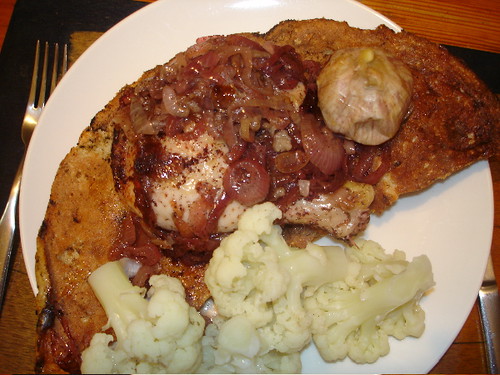Israel depends on a rainy winter for its water supply for the rest of the year. We have had a serious drought here that no one is taking seriously. However, the last few weekends we have had a significant amount of much needed rain.
Rain and cold always demand hot and hearty dishes to keep us warm and cozy inside and out. There is a another sale at our local supermarket on lamb; this time the sale is on lamb neck. I don’t think lamb neck is readily available at supermarkets or butchers in most parts of the US and Canada, but you may be able to find it at a Halal butcher in larger cities with a Muslim population. If not, you could always use lamb shoulder. I don’t think you will have a problem finding it in Europe.
This lamb recipe was published in Haaretz newspaper a couple of weeks ago and is from a famous restaurant in Nazareth called Diana’s. It specializes in meat, especially lamb kebab that is chopped by hand, and seafood.
The seasoning of the lamb is more subtle than usual for middle eastern food: even though one tablespoon each of allspice, nutmeg and cinnamon appears to be a lot, this is for quite a large quantity of meat and none of the spices has a very strong taste to begin with. It is very important to let the meat cook on a very low flame for long enough to become really tender: in fact, if you can cook the meat (without adding the spinach) the day before and then cook it again for about 30 minutes (following the rest of the instructions) just before serving, it will be even better.

- 4 pieces lamb neck with the bone weighing approximately 350g (3/4lb) each
- 1 tablespoon ground allspice
- 1 tablespoon grated nutmeg
- 1 tablespoon ground cinnamon
- Olive oil
- 8 whole shallots peeled
- 8 whole garlic cloves peeled
- 5 garlic cloves crushed
- 1 kg 2 lbs fresh medium size spinach leaves, stems removed, rinsed well and coarsely chopped
-
Mix the spices together. Lightly salt the meat and rub the spices on both sides of the lamb neck.
-
Heat a little olive oil in a skillet and saute the pieces of meat until they start to brown. Transfer the meat to a large pot. Saute the whole shallots and the whole garlic cloves and add to the pot with the meat. Pour in enough water to cover and bring to a boil. Cook for about an hour over a high flame.
-
Lower the flame and skim off the foam that has formed on top. Simmer for an additional two hours over a low flame until the meat is very tender.
-
Add the spinach leaves and simmer for 5-10 minutes.
-
Meanwhile, add olive oil to a pan and saute the crushed garlic until golden. Add the garlic to the stew, mix and adjust seasoning to taste. Serve over rice.
For dessert, I used a new carrot cake recipe that I hadn’t tried before. This cake is spicy, but not sweet at all except for the natural sweetness of the carrot, in spite of the fact that it calls for 1-1/2 cups of icing sugar. So if you like very sweet cakes, this one might not be for you.

- 3 cups all-purpose flour
- 1 cup vegetable oil
- 1 1/2 cups icing sugar confectioner's sugar
- 1 cup crushed walnuts
- 1 cup grated carrots
- 1 cup milk or water
- 6 eggs
- 1 teaspoon baking soda
- 1 teaspoon vanilla extract
- 3 teaspoons baking powder
- 2 teaspoons ground cinnamon
- 1/2 teaspoon ground clove
- 1/2 teaspoon ground nutmeg
- 1/2 teaspoon ground cardamom
-
Preheat oven to 170C (350F). Grease and flour one large tube pan.
-
Sift the flour, baking soda, and baking powder together and set aside. Beat the eggs together with the spices for 5 minutes. Stir in the icing sugar and mix well. Beat in the vegetable oil and continue beating for 5 minutes.
-
Alternately add the flour mixture and the milk or water, 1 tablespoon at a time, to the egg mixture. With a spoon stir in the carrots and the walnuts. Pour batter into prepared pan.
-
Bake at 170F (350F) for 1 hour.



























